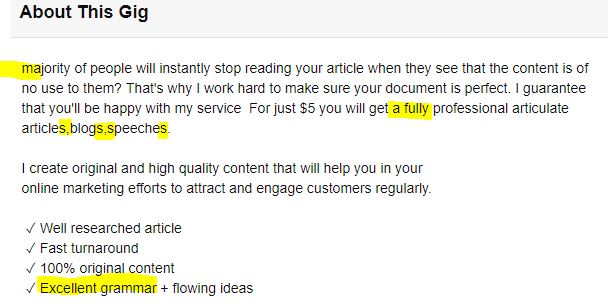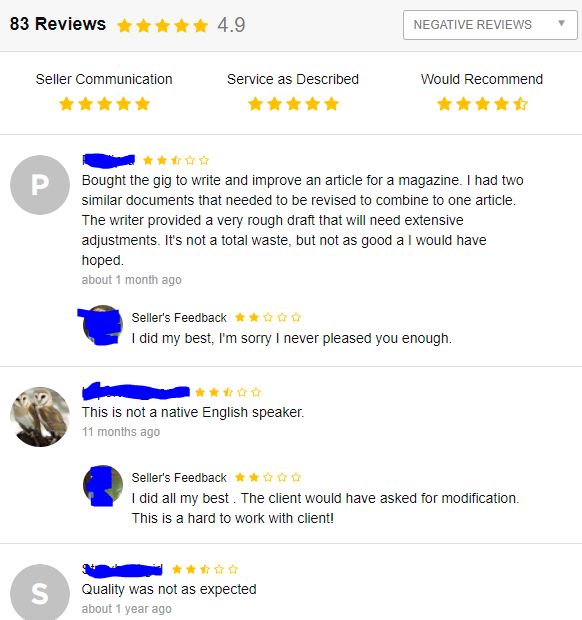In the last two installments of Freelance Marketplaces, we talked about what you can get for five dollars, and some of the dangers that lie ahead in your journey to find a good freelancer through Fiverr and other freelance marketplaces. Even though there are some things you have to deal with, there are still good folks on these platforms who want to do a good job for you. You just have to keep a few things in mind while using these services — research your seller, build relationships with the “good” sellers, have a set of verification tools ready, and use customer service.
Research Your Seller
I can’t stress this enough. Spend a few minutes researching any sellers that you are thinking about using on one of these freelance platforms. You will be surprised what you can pick up on just by paying a little attention upfront.
Catch Lazy/Inept Sellers Fast
In the Articles & Blog Posts category (where I spent most of my time), the easiest thing you can do is just read the description of any potential seller’s Gig. One rule I started using is that if they can’t even spend the time to write a grammatically sound description of what they are offering (especially for offering writing skills!), then I would not even bother with them. As an example, this seller guarantees that you’ll be happy with his work and lists “Excellent Grammar” as one of the features for his Gig, but he can’t bother to do simple things like capitalize the first word of a sentence or proof read to find improper usage of singular/plural nouns.

If the seller on your freelance service of choice cannot string together a grammatically sound description, PASS! Otherwise, you’ll spend so much time fixing these issues that you could have written a perfect article in less time.
Feedback is King. Feedback is a Lie.
Another thing you can do to catch issues before entering a transaction is read the reviews of any potential sellers. However, this comes with a caveat. The only way I can explain this is that some of the evil characters (from the last post) have banded together to give positive reviews to each other. I have purchased from a few sellers with 5.0 reviews but received steaming piles from them as output. I recommend viewing the positive reviews and the negative reviews. A lot of times you will find that, unfortunately, the negative reviews paint a picture of what you can expect. Take the reviews below, for instance:

These are the things you most likely also will have to deal with. As I pointed out in part 2 of this series, this is one of the many sellers that may not be writing for his native language. There’s nothing wrong with this, so long as you can properly construct a piece of work in your buyer’s language, which this seller does not appear to be able to do. I’ve seen this time and time again on Fiverr, and I’m sure this probably happens on other freelance offerings as well.
Build Relationships with the Good Sellers
If you find a seller on any of the freelance marketplaces that delivers quality content, then put them on your favorites list and open up a line of communication with them so that you are both on the same page about expectations of any future jobs. I’m telling you it can be quite hard to find good work, so if you do find it, hang on to it! I have used a couple of sellers multiple times after finding that they delivered content that was decent and required minimal editing after I received it.
Verification Tools
Once you do find a seller and pull the trigger, you will eventually receive your deliverable. You will then have to spend some time to make sure that the work is original and meets your standards. As I mentioned in the last part of this series, there are sellers that will plagiarize, and there are sellers that won’t proof read and cannot write. You will have to do the proof reading and verification to detect these issues in your final product.
Plagiarism
If you do a Google search for plagiarism checker, you will find quite a few. Some are free, and some are not. Whatever you choose, I recommend using 2 or 3 at least. I have run pieces of work through some well-known checkers and they came up clean. When I ran them through a random, free tool I found, however, it caught just enough similarities that I was able to follow the linked article and see that the seller just re-worded the whole article. Below is an example of what you’ll see when you search. Grammarly seems to be a popular one, but it’s not free.

I have tested a few of these while checking the content I’ve received from freelance sites, but I haven’t purchased anything yet. Everyone is out to get my money as a blogger, and from what I can tell, none of the services I’ve used so far can do this job on their own, so I can’t justify paying for any of them.
Bad Grammar
Another thing you will have to watch for is bad grammar. One of the best things you can do is take the article you have received and put it in a proper text editor (Word, Libre, Google Docs, whatever you use), and see what it flags. This will help you catch spelling and easy grammar mistakes. After that, you can search for tools to do this job for you as well. However, no automated tool for grammar is as good as you proof reading on your own. You are the best verification tool that you possess when it comes to this!
Customer Service – The Freelance Arbitrators
 Last, but not least, if you do find your self on the raw side of a transaction, utilize Fiverr‘s customer service. This includes the Resolution Center that they provide. I have had to cancel a few Gigs that went bad. Most of the time the Resolution Center works fine, but if there are any hiccups, just open up a ticket with customer service, and they will take care of you. Provide them as much proof as possible for why you are requesting a refund or cancellation. I’m sure the other freelance marketplaces have similar systems in place to protect buyers and sellers.
Last, but not least, if you do find your self on the raw side of a transaction, utilize Fiverr‘s customer service. This includes the Resolution Center that they provide. I have had to cancel a few Gigs that went bad. Most of the time the Resolution Center works fine, but if there are any hiccups, just open up a ticket with customer service, and they will take care of you. Provide them as much proof as possible for why you are requesting a refund or cancellation. I’m sure the other freelance marketplaces have similar systems in place to protect buyers and sellers.
Final Thoughts
That ends this three part series on freelance market places. These services are great time savers for many categories of work, but you have to put a little time in to make sure you are getting quality work. A lot of your time spent should be upfront so that you reduce your chances of even getting mixed up in a bad transaction. Hopefully this guide will help you out if you are just starting to use these services.
Do you have any positive or negative experiences using these platforms? We’d like to hear about them in the comments below. Until next time, stay big!

